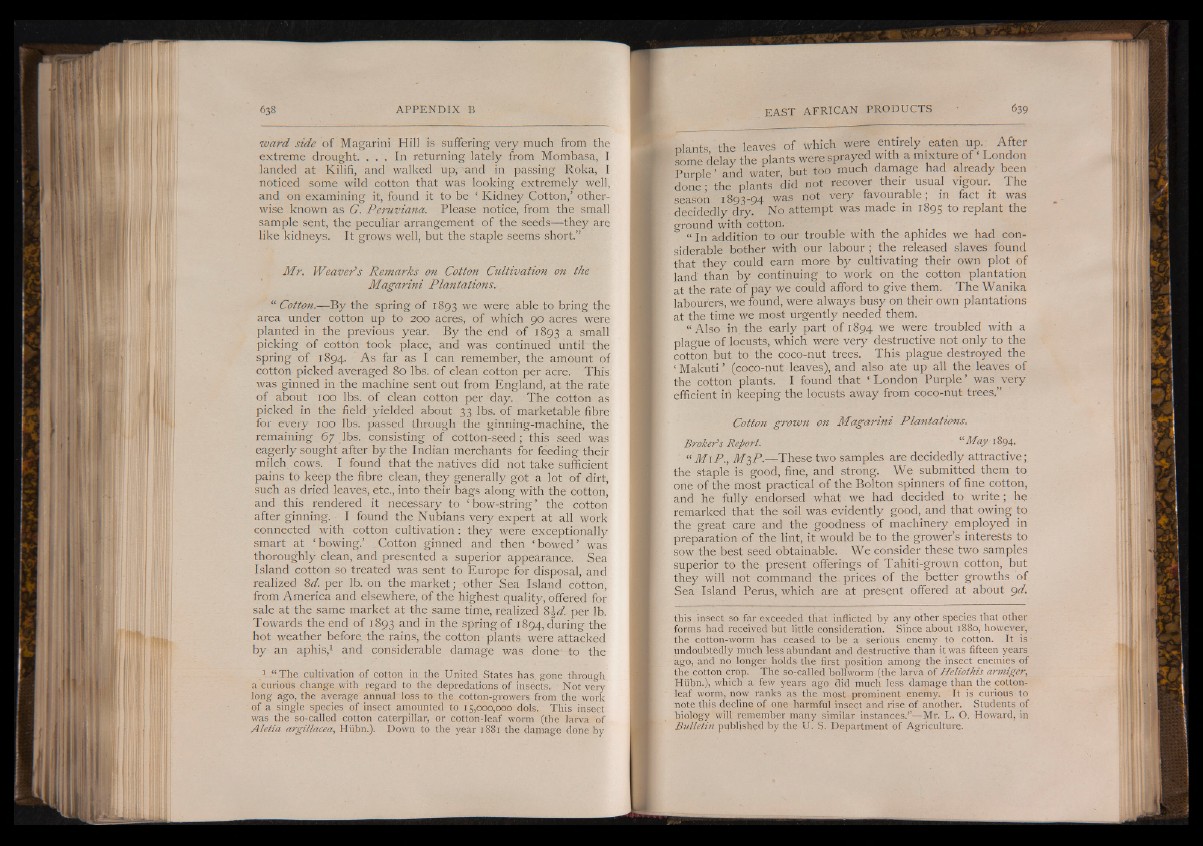
ward side of Magarini Hill is suffering very much from the
■extreme drought. . . . In returning lately from Mombasa, I
landed at Kilifi, and walked up, 'and in passing Roka, I
noticed some wild cotton that was looking extremely well,
and on examining it, found it to be ‘ Kidney Cotton,’ otherwise
known as G. Peruviana. Please notice, from the small
sample sent, the peculiar arrangement of the seeds— they are
like kidneys. It grows well, but the staple seems short.”
Mr. Weaver’s Remarks on Cotton Cultivation on the
Magarini Plantations.
“ Cotton.— By the spring of 1893 we were able to bring the
area under cotton up to 200 acres, of which 90 acres were
planted in the previous year. By the end of 1893 a small
picking of cotton took place, and was continued until the
spring of 1894. As far as I can remember, the amount of
cotton picked averaged 80 lbs. of clean cotton per acre. This
was ginned in the machine sent out from England, at the rate
of about 100 lbs. of clean cotton per day. The cotton as
picked in the field- yielded about 33 lbs. of marketable fibre
for every 100 lbs. passed through the ginning-machine, the
remaining 67 lbs. consisting of cotton-seed ; this seed was
eagerly sought after by the Indian merchants for feeding their
milch, cows. I found that the natives did not take sufficient
pains to keep the fibre clean, they generally got a lot of dirt,
such as dried leaves, etc., into their bags along with the cotton,
and this rendered it necessary to ‘ bow-string’ the cotton
after ginning. I found the Nubians very expert at all work
connected with cotton cultivation: they were exceptionally
smart at ‘ bowing.’ Cotton ginned and then ‘ bowed’ was
thoroughly clean, and presented a superior appearance. Sea
Island cotton so treated was sent to Europe for disposal, and
realized 8d. per lb. on the market ; other Sea Island cotton,
from America and elsewhere, of the highest quality, offered for
sale at the same market at the same time, realized 8\d. per lb.
Towards the end of 1893 and in the spring of 1894, during the
hot weather before the rains, the cotton plants were attacked
by an aphis,1 and considerable damage was done—to the
1 “ The cultivation of cotton in the United States has. gone through
a curious change with regard to the depredations of insects. Not very-
long ago, the average annual loss to the cotton-growers from the work
of a single species of insect amounted to 15,000,000 dols. This insect
was the so-called cotton caterpillar, or cotton-leaf worm (the larva of
Aletia argillacea, Htibn.). Down to the year 1881 the datriage done by
olants the leaves of which were entirely eaten up. After
some delay the plants were sprayed with a mixture of ‘ London
Purple’ and water, but too much damage had already been
done - the plants did not recover their usual vigour. The
season 1893-94 was not very favourable; in fact it was
decidedly dry. No attempt was made in 1895 to replant the
ground with cotton.
“ In addition to our trouble with the aphides we had considerable
bother with our labour; the released slaves found
that they could earn more by cultivating their own plot of
land than by continuing to work on the cotton plantation
at the rate of pay we could afford to give them. The Wanika
labourers, we found, were always busy on their own plantations
at the time we most urgently needed them.
“ Also in the early part of 1894 we were troubled with a
plague of locusts, which were very destructive not only to the
cotton but to the coco-nut trees. This plague destroyed the
‘ Makuti ’ (coco-nut leaves), and also ate up all the leaves of
the cotton plants. I found that ‘ London Purple ’ was very
efficient iri keeping the locusts away from coco-nut trees,”
Cotton grown on Magarini Plantations.
Broker's Report. “ May 1894.
' “ MiP., M3 P.— These two samples are decidedly attractive;
the staple is good, fine, and strong. We submitted them to
one of the most practical of the Bolton spinners of fine cotton,
and he fully endorsed what we had decided to write; he
remarked that the soil was evidently good, and that owing to
the great care and the goodness of machinery employed in
preparation of the lint, it would be to the grower’s interests to
sow the best seed obtainable. We consider these two samples
superior to the present offerings of Tahiti-grown cotton, but
they will not command the prices of the better growths of
Sea Island Perus, which are at present offered at about gd.
this insect so far exceeded that inflicted by any other species that other
forms had received but little consideration. Since about 1880, however,
the cotton-worm has ceased to be a serious enemy to cotton. It is
undoubtedly much less abundant and destructive than it was fifteen years
ago, and no longer holds the first position among the insect enemies of
the cotton crop. The so-called bolhvorm (the larva of Heliothis armiger,
Hiibn.), which a few years ago did much less damage than the cotton-
leaf worm, now ranks as the most prominent enemy. It is curious to
note this decline of one harmful insect and rise of another. Students of
biology will remember many similar instances.”— Mr. L. O. Howard, in
Bulletin published by the U. S. Department of Agriculture.